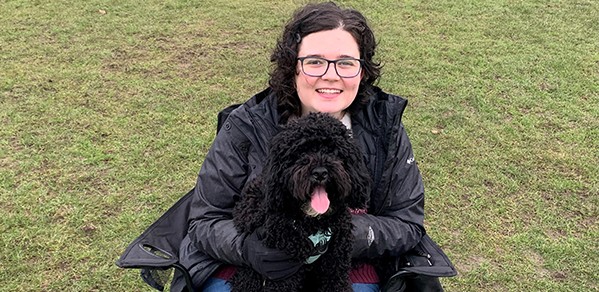
For Gates Cambridge Scholar Lyndie Zollinger, studying medical challenges from a mechanical perspective presents the ultimate puzzle. This is why, for her PhD, she is using biomechanical modelling and image analysis techniques to take a closer look at specific knee injuries in dogs and humans (a similar injury shared by both species).
An injury fuelled my passion for studying medical challenges from a mechanical perspective. I love being able to use mechanics to break things down and understand what is actually causing a medical issue. For me, it is like solving a mechanics puzzle.
Lyndie Zollinger
Lyndie will analyse motion patterns and detect abnormalities to help with injury diagnosis, treatment and monitoring.
Here, she reveals more about her research, as part of our Women in Engineering series.
I have a family history of knee injuries and this definitely influenced my decision to study knees. When I was around 13 years old, my brother had knee surgery and I was fascinated by his doctor's explanation for what was causing his problems. I ended up using some PVC pipes, bottle caps and rubber bands to build some models and test what was happening. At the time, I did not know that counted as engineering or even what engineering was, but I had a lot of fun doing it!
I injured my own knee when a giant hamster wheel fell on top of me. It happened during a class activity at MIT – Massachusetts Institute of Technology, where I was studying mechanical engineering. This incident fuelled my passion for studying medical challenges from a mechanical perspective. I love being able to use mechanics to break things down and understand what is actually causing a medical issue. For me, it is like solving a mechanics puzzle.
You can gain valuable information about someone's health just from monitoring the way in which that person moves and walks. Walking requires the brain, spinal cord, bones, muscles and other tissues to work together in order to move properly. If something is wrong in one or more of these components, then it can affect how we walk in noticeable ways. Studying the changes in someone's gait can help determine where and why a problem is occurring. Once we know why something is happening, we can then use mechanical modelling to explore how different changes would affect the gait and thus find the ideal treatment for it.
I have always loved dogs. When I was discussing project ideas with my supervisor Professor Michael Sutcliffe, he mentioned that he wanted to collaborate more with the Cambridge Veterinary School. Therefore, under the supervision of Professor Matthew Allen, from the Department of Veterinary Medicine, I took up the exciting opportunity to work with dogs and research ways in which to help them. I ultimately chose to focus on studying knees for my PhD research, because they are structurally quite similar in both dogs and humans. I am focusing on increasing the availability of gait analysis for injury diagnosis, treatment and monitoring in both species.
Studying differences between dog breeds can provide insights into some of the natural diversity among humans – something that is often overlooked in medical research data. My research combines portable low-cost imaging techniques with biomechanical modelling to analyse motion patterns, detect abnormalities and identify specific knee injuries in humans and dogs. This method of gait analysis has the potential to enable GPs, physiotherapists and other medical professionals to assess patient gait without the need for referral to specialised, expensive, and often overwhelmed, gait clinics. This can help speed up assessments, reduce patient backlogs and enable at-home monitoring of patients as they recover from injuries, ensuring that they stay on track for a normal recovery.
Believe to achieve
The first woman in my neighbourhood who had a STEM career moved there when I was 16. She was also the first woman I met who had a PhD. Meeting her inspired me to believe I could do what I loved, even if many other people told me it was not possible.
As I pursue a PhD and academic career in biomechanics, I want to continue mentoring and inspiring more gender minorities to pursue their dreams in STEM fields. During my undergraduate degree, I worked as a teaching assistant for several courses and as a tutor for a programme that introduced teenage gender minorities to engineering. I loved working with students and seeing them learn and understand new things. I now supervise second-year undergraduates at Cambridge.
To gender minorities interested in engineering, my advice is believe you can do it. Find mentors and role models that inspire and help you to keep going, even when others seem to be trying to stop you. I do not want anyone to be discouraged out of engineering because they do not think they can do it. If you are interested in it and find the right people to help you with it, you can make it happen!

